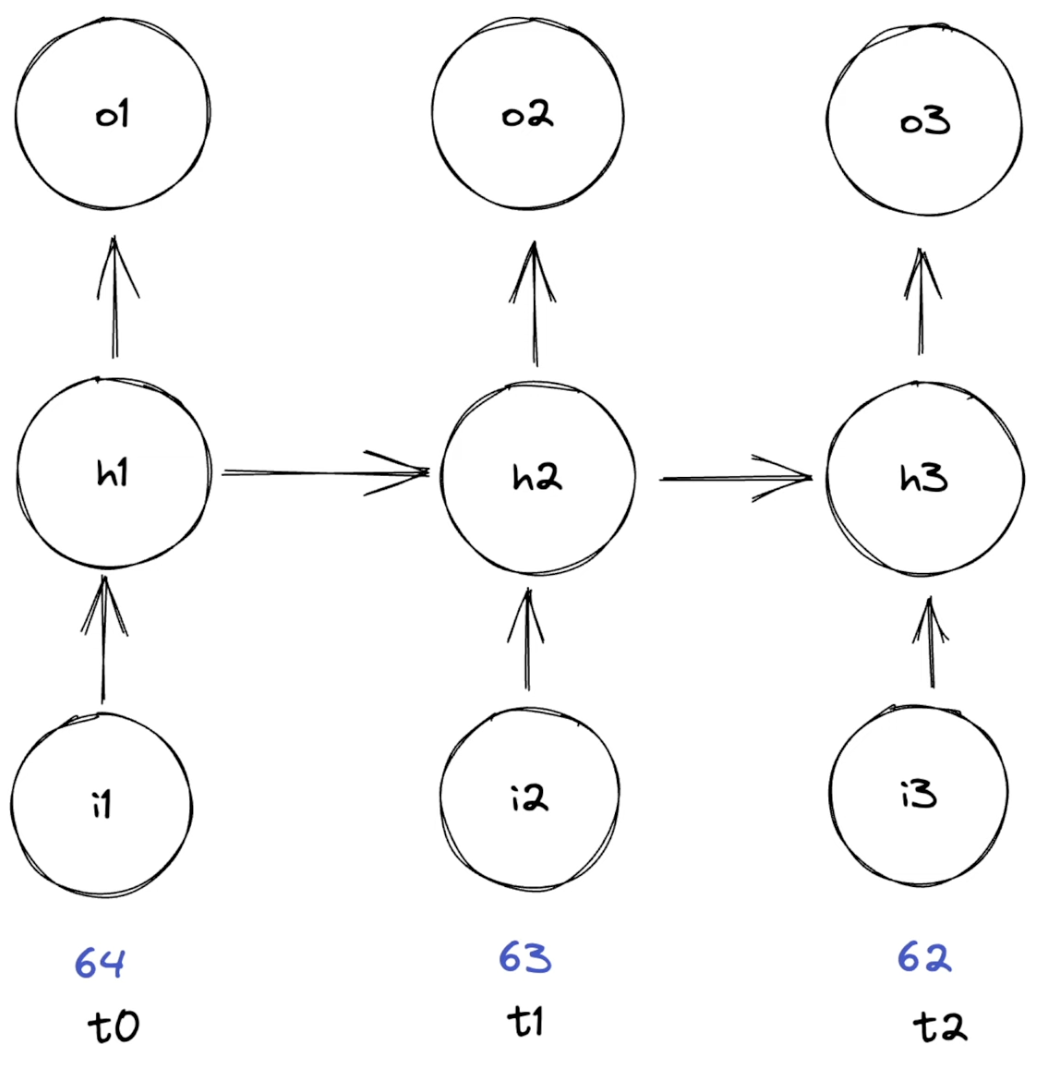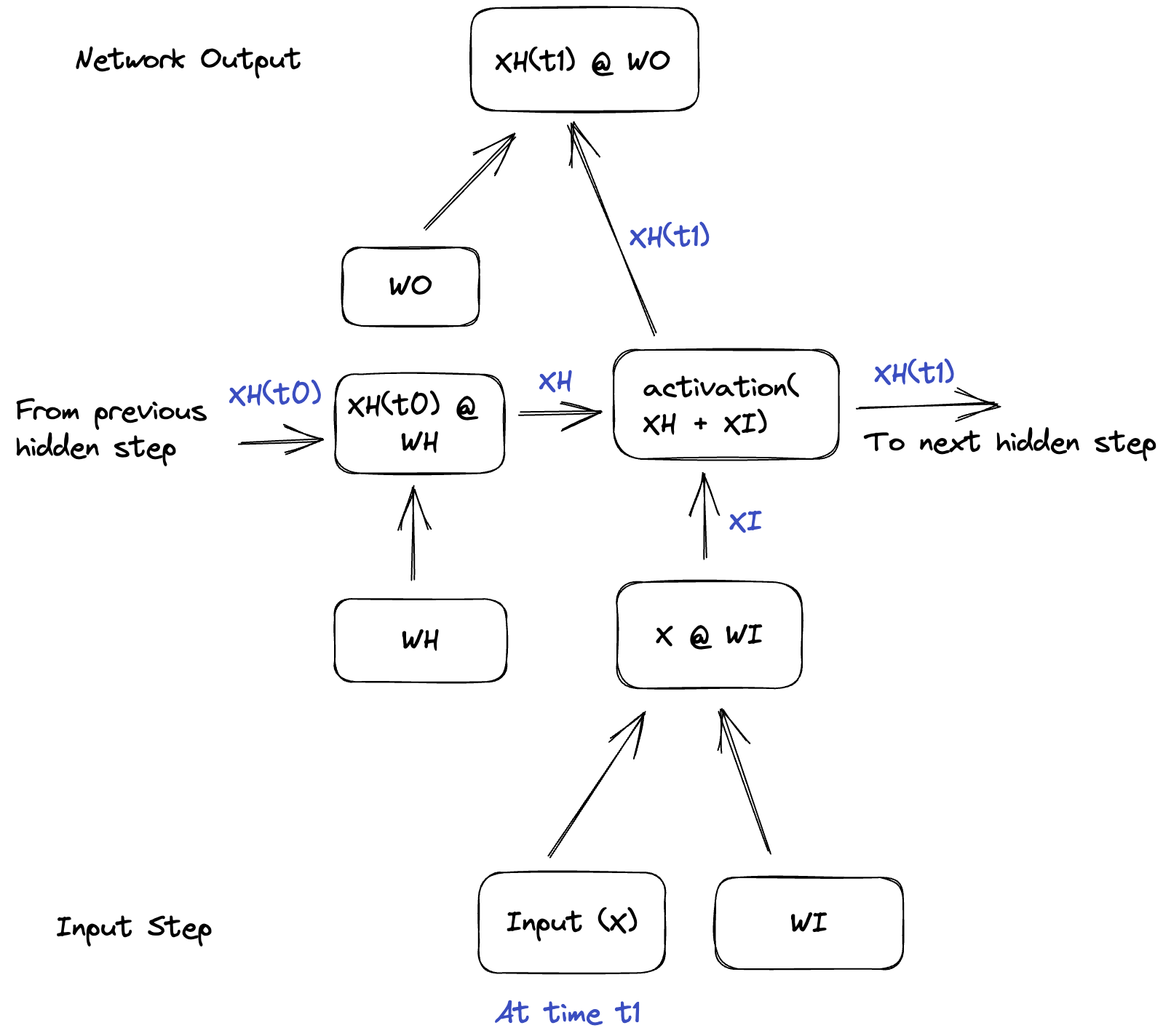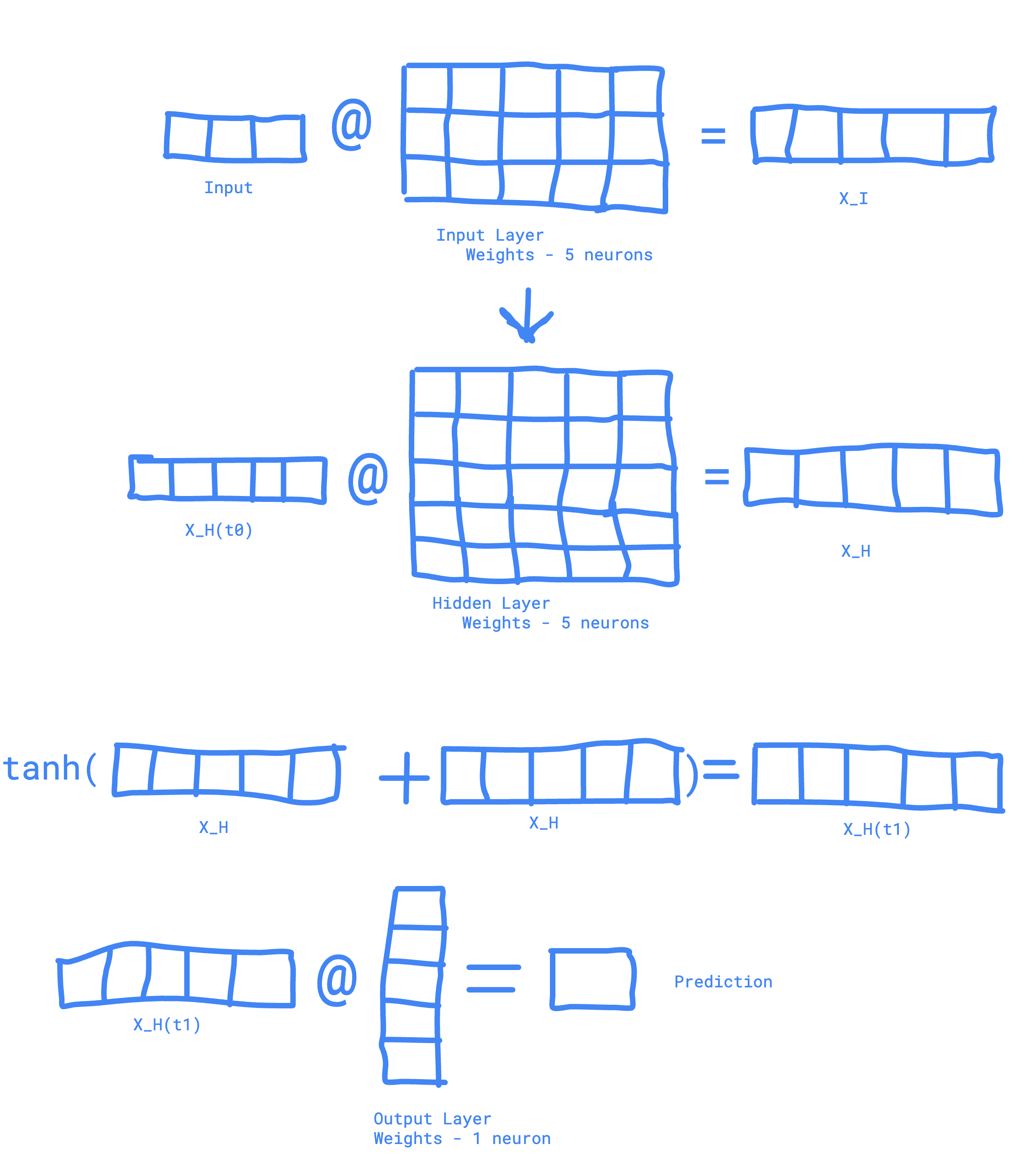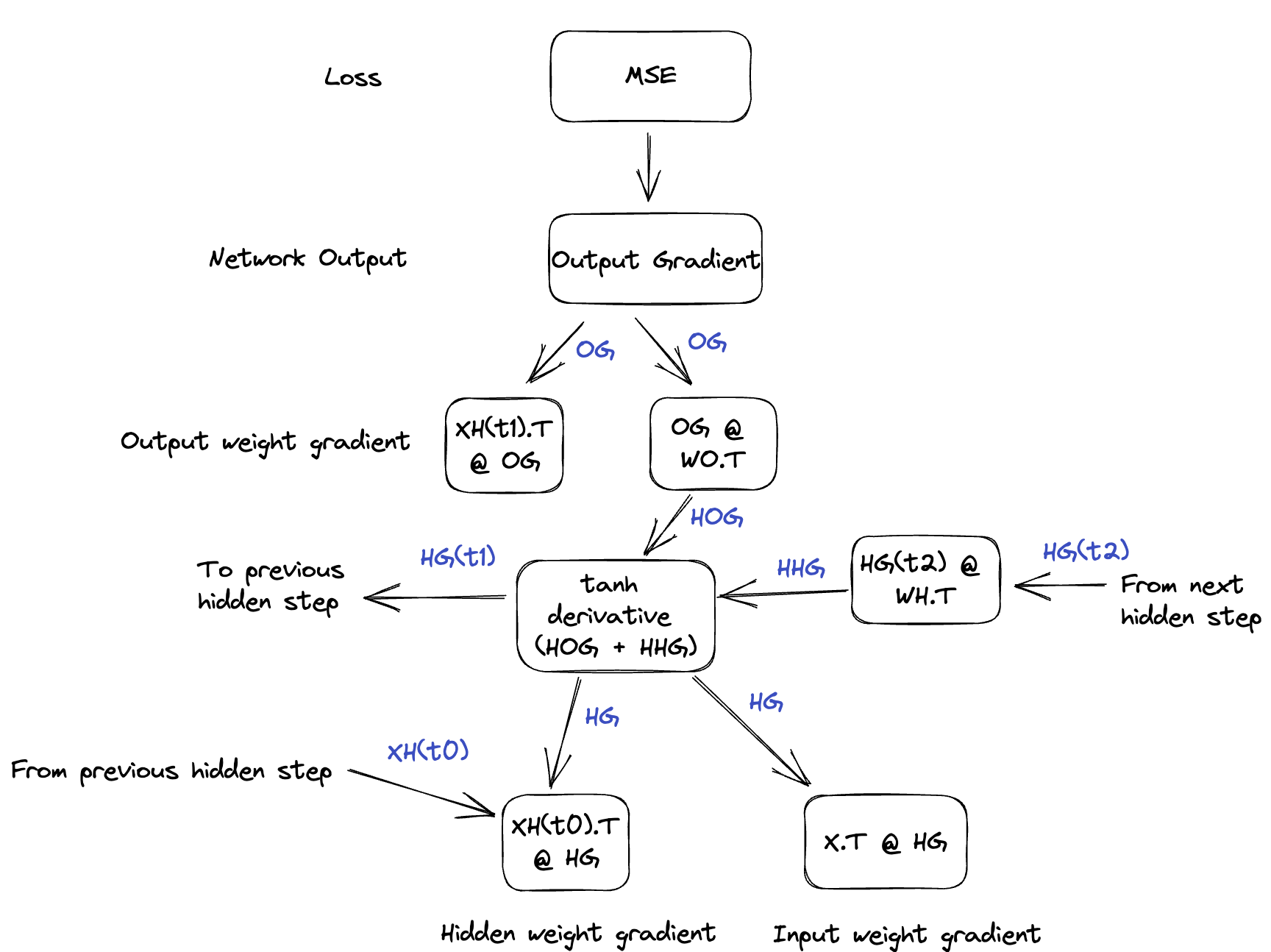RNN from scratch¶
RNNs acts as sequence processors. They take a sequence of inputs, and produce a sequence of outputs. The input sequence length is variable, it can take a sequence of 7 steps or 7000 steps, doesn't matter.
We have:
- Input layer: one weights matrix and one bias vector
- Hidden layer: one weights matrix and one bias vector
- Output layer: one weights matrix and one bias vector

For each input X, we have:
- Input layer: $XI = X \times W_i + b_i$
- Hidden layer: $XH(t_n) = \text{activation}(XH(t_{n-1}) + XI)$
- Output layer: $XO = XH(t_n) \times W_o + b_o$


- Input has 3 features so its shape is: (1, 3)
- Input layer has 5 neurons, so its weights shape is: (3, 5). XI has shape (1, 5)
- Hidden layer has 5 neurons, so its weights shape is: (5, 5). XH has shape (1, 5) as it XH_previous (1,5) @ H_weights (5,5) = (1,5). XI+XH has shape (1, 5). The resulting XH has shape (1, 5).
- Output layer has 1 neuron, so its weights shape is: (5, 1). XO has shape (1, 1)
Install required packages¶
!pip install torch matplotlib
Download the data¶
!curl https://raw.githubusercontent.com/VikParuchuri/zero_to_gpt/refs/heads/master/data/clean_weather.csv -o clean_weather.csv
% Total % Received % Xferd Average Speed Time Time Time Current
Dload Upload Total Spent Left Speed
100 396k 100 396k 0 0 727k 0 --:--:-- --:--:-- --:--:-- 726k
Import libraries¶
import pandas as pd
import numpy as np
Read the data¶
Each row is a day, with columns for each weather variable. We have tmax, tmin, rain. tmax_tomorrow is the target, what we're trying to predict.
ffill fills in missing values with the last known value.
# Read in our data, and fill missing values
data = pd.read_csv("./clean_weather.csv", index_col=0)
data = data.ffill()
data
| tmax | tmin | rain | tmax_tomorrow | |
|---|---|---|---|---|
| 1970-01-01 | 60.0 | 35.0 | 0.0 | 52.0 |
| 1970-01-02 | 52.0 | 39.0 | 0.0 | 52.0 |
| 1970-01-03 | 52.0 | 35.0 | 0.0 | 53.0 |
| 1970-01-04 | 53.0 | 36.0 | 0.0 | 52.0 |
| 1970-01-05 | 52.0 | 35.0 | 0.0 | 50.0 |
| ... | ... | ... | ... | ... |
| 2022-11-22 | 62.0 | 35.0 | 0.0 | 67.0 |
| 2022-11-23 | 67.0 | 38.0 | 0.0 | 66.0 |
| 2022-11-24 | 66.0 | 41.0 | 0.0 | 70.0 |
| 2022-11-25 | 70.0 | 39.0 | 0.0 | 62.0 |
| 2022-11-26 | 62.0 | 41.0 | 0.0 | 64.0 |
13509 rows × 4 columns
The most common activation function for RNNs is the tanh function:
$$ \text{tanh}(x) = \frac{e^x - e^{-x}}{e^x + e^{-x}} $$
The derivative of the tanh function is:
$$ \text{tanh}'(x) = 1 - \text{tanh}(x)^2 $$
Let's graph the tanh function and its derivative:
import matplotlib.pyplot as plt
x = np.linspace(-10, 10, 100)
y = np.tanh(x)
dy = 1 - y**2
plt.plot(x, y, label='tanh(x)')
plt.plot(x, dy, label="tanh'(x)")
plt.legend()
plt.show()
Full Implementation¶
from sklearn.preprocessing import StandardScaler
import math
# Define predictors and target
PREDICTORS = ["tmax", "tmin", "rain"]
TARGET = "tmax_tomorrow"
# Scale our data to have mean 0
scaler = StandardScaler()
data[PREDICTORS] = scaler.fit_transform(data[PREDICTORS])
# Split into train, valid, test sets: 70% train, 15% valid, 15% test
np.random.seed(0)
split_data = np.split(data, [int(.7*len(data)), int(.85*len(data))])
(train_x, train_y), (valid_x, valid_y), (test_x, test_y) = [[d[PREDICTORS].to_numpy(), d[[TARGET]].to_numpy()] for d in split_data]
/Users/LSoica/work/AI/blog/.venv/lib/python3.12/site-packages/numpy/core/fromnumeric.py:59: FutureWarning: 'DataFrame.swapaxes' is deprecated and will be removed in a future version. Please use 'DataFrame.transpose' instead. return bound(*args, **kwds)
def init_params(layer_conf):
layers = []
for i in range(1, len(layer_conf)):
np.random.seed(0)
k = 1/math.sqrt(layer_conf[i]["hidden"])
i_weight = np.random.rand(layer_conf[i-1]["units"], layer_conf[i]["hidden"]) * 2 * k - k
h_weight = np.random.rand(layer_conf[i]["hidden"], layer_conf[i]["hidden"]) * 2 * k - k
h_bias = np.random.rand(1, layer_conf[i]["hidden"]) * 2 * k - k
o_weight = np.random.rand(layer_conf[i]["hidden"], layer_conf[i]["output"]) * 2 * k - k
o_bias = np.random.rand(1, layer_conf[i]["output"]) * 2 * k - k
layers.append(
[i_weight, h_weight, h_bias, o_weight, o_bias]
)
return layers
forward pass¶
# using mean squared error as loss function
def mse(actual, predicted):
return np.mean((actual-predicted)**2)
# mse gradient is the difference between actual and predicted. It the negative of the mse derivative
def mse_grad(actual, predicted):
return (predicted - actual)
# we run through the network a sequence of 20 inputs. start with hidden state and output state as 0
def forward(x, layers):
hiddens = []
outputs = []
for i in range(len(layers)):
i_weight, h_weight, h_bias, o_weight, o_bias = layers[i]
hidden = np.zeros((x.shape[0], i_weight.shape[1]))
output = np.zeros((x.shape[0], o_weight.shape[1]))
for j in range(x.shape[0]):
input_x = x[j,:][np.newaxis,:] @ i_weight
hidden_x = input_x + hidden[max(j-1,0),:][np.newaxis,:] @ h_weight + h_bias
# Activation. tanh avoids outputs getting larger and larger.
hidden_x = np.tanh(hidden_x)
# Store hidden for use in backprop
hidden[j,:] = hidden_x
# Output layer
output_x = hidden_x @ o_weight + o_bias
output[j,:] = output_x
# Store hidden and output for use in backprop
hiddens.append(hidden)
outputs.append(output)
return hiddens, outputs[-1]
Backward pass¶
NN backpropagation function is:
$$ \text{NN} = tanh((Input @ I_w + I_b) + (XH(t_n-1) @ H_w + H_b)) @ O_w + O_b $$

def backward(layers, x, lr, grad, hiddens):
for i in range(len(layers)):
i_weight, h_weight, h_bias, o_weight, o_bias = layers[i]
hidden = hiddens[i]
next_h_grad = None
i_weight_grad, h_weight_grad, h_bias_grad, o_weight_grad, o_bias_grad = [0] * 5
for j in range(x.shape[0] - 1, -1, -1):
# Add newaxis in the first dimension
out_grad = grad[j,:][np.newaxis, :]
# Output updates
# np.newaxis creates a size 1 axis, in this case transposing matrix
o_weight_grad += hidden[j,:][:, np.newaxis] @ out_grad
o_bias_grad += out_grad
# Propagate gradient to hidden unit
h_grad = out_grad @ o_weight.T
if j < x.shape[0] - 1:
# Then we multiply the gradient by the hidden weights to pull gradient from next hidden state to current hidden state
hh_grad = next_h_grad @ h_weight.T
# Add the gradients together to combine output contribution and hidden contribution
h_grad += hh_grad
# Pull the gradient across the current hidden nonlinearity
# derivative of tanh is 1 - tanh(x) ** 2
# So we take the output of tanh (next hidden state), and plug in
tanh_deriv = 1 - hidden[j][np.newaxis,:] ** 2
# next_h_grad @ np.diag(tanh_deriv_next) multiplies each element of next_h_grad by the deriv
# Effect is to pull value across nonlinearity
h_grad = np.multiply(h_grad, tanh_deriv)
# Store to compute h grad for previous sequence position
next_h_grad = h_grad.copy()
# If we're not at the very beginning
if j > 0:
# Multiply input from previous layer by post-nonlinearity grad at current layer
h_weight_grad += hidden[j-1][:, np.newaxis] @ h_grad
h_bias_grad += h_grad
i_weight_grad += x[j,:][:,np.newaxis] @ h_grad
# Normalize lr by number of sequence elements
lr = lr / x.shape[0]
i_weight -= i_weight_grad * lr
h_weight -= h_weight_grad * lr
h_bias -= h_bias_grad * lr
o_weight -= o_weight_grad * lr
o_bias -= o_bias_grad * lr
layers[i] = [i_weight, h_weight, h_bias, o_weight, o_bias]
return layers
Training¶
epochs = 21
lr = 0.0001
sequence_len = 13
layer_conf = [
{"type":"input", "units": 3},
{"type": "rnn", "hidden": 5, "output": 1}
]
layers = init_params(layer_conf)
for epoch in range(epochs):
epoch_loss = 0
for j in range(train_x.shape[0] - sequence_len):
seq_x = train_x[j:(j+sequence_len),]
seq_y = train_y[j:(j+sequence_len),]
hiddens, outputs = forward(seq_x, layers)
grad = mse_grad(seq_y, outputs)
params = backward(layers, seq_x, lr, grad, hiddens)
epoch_loss += mse(seq_y, outputs)
if epoch % 2 == 0:
valid_loss = 0
for j in range(valid_x.shape[0] - sequence_len):
seq_x = valid_x[j:(j+sequence_len),]
seq_y = valid_y[j:(j+sequence_len),]
_, outputs = forward(seq_x, layers)
valid_loss += mse(seq_y, outputs)
print(f"Epoch: {epoch} train loss {epoch_loss / len(train_x)} valid loss {valid_loss / len(valid_x)}")
history = np.array([[60.0, 38.0, 0.0], [65.0, 39.0, 0.0], [66.0, 36.0, 0.0], [64.0, 38.0, 0.0], [63.0, 38.0, 0.0], [62.0, 42.0, 0.0], [61.0, 37.0, 0.0], [60.0, 36.0, 0.0], [62.0, 35.0, 0.0], [67.0, 38.0, 0.0], [66.0, 41.0, 0.0], [70.0, 39.0, 0.0], [62.0, 41.0, 0.0]])
_, predictions = forward(history, layers)
print(f"Prediction: {predictions[-1][0]} vs actual: 64")
Epoch: 0 train loss 519.6897645583397 valid loss 72.75332393001642 Prediction: 66.62851833139118 vs actual: 64 Epoch: 2 train loss 36.42163982733737 valid loss 34.5787728792624 Prediction: 77.24747225976233 vs actual: 64 Epoch: 4 train loss 27.382911331350147 valid loss 29.880311580291163 Prediction: 83.61372429665458 vs actual: 64 Epoch: 6 train loss 23.86992827107105 valid loss 29.5155110803209 Prediction: 87.15185060463273 vs actual: 64 Epoch: 8 train loss 22.097282189052727 valid loss 28.867248732991 Prediction: 89.56176331634961 vs actual: 64 Epoch: 10 train loss 21.19754778288571 valid loss 28.319600958096984 Prediction: 90.9757596641493 vs actual: 64 Epoch: 12 train loss 20.80703158428252 valid loss 28.007075069070954 Prediction: 91.67585229723386 vs actual: 64 Epoch: 14 train loss 20.624720897995743 valid loss 27.795451578250965 Prediction: 91.98200920596689 vs actual: 64 Epoch: 16 train loss 20.534074732042967 valid loss 27.6354128815431 Prediction: 91.98152140187526 vs actual: 64 Epoch: 18 train loss 20.48957190776276 valid loss 27.51225526508315 Prediction: 88.98640924101369 vs actual: 64 Epoch: 20 train loss 20.470074809311015 valid loss 27.428434472209506 Prediction: 62.98421948718461 vs actual: 64
# 2022-11-14,60.0,38.0,0.0,65.0
# 2022-11-15,65.0,39.0,0.0,66.0
# 2022-11-16,66.0,36.0,0.0,64.0
# 2022-11-17,64.0,38.0,0.0,63.0
# 2022-11-18,63.0,38.0,0.0,62.0
# 2022-11-19,62.0,42.0,0.0,61.0
# 2022-11-20,61.0,37.0,0.0,60.0
# 2022-11-21,60.0,36.0,0.0,62.0
# 2022-11-22,62.0,35.0,0.0,67.0
# 2022-11-23,67.0,38.0,0.0,66.0
# 2022-11-24,66.0,41.0,0.0,70.0
# 2022-11-25,70.0,39.0,0.0,62.0
# 2022-11-26,62.0,41.0,0.0,64.0
history = np.array([[60.0, 38.0, 0.0], [65.0, 39.0, 0.0], [66.0, 36.0, 0.0], [64.0, 38.0, 0.0], [63.0, 38.0, 0.0], [62.0, 42.0, 0.0], [61.0, 37.0, 0.0], [60.0, 36.0, 0.0], [62.0, 35.0, 0.0], [67.0, 38.0, 0.0], [66.0, 41.0, 0.0], [70.0, 39.0, 0.0], [62.0, 41.0, 0.0]])
_, predictions = forward(history, layers)
# print all predictions
print(predictions)
# print last prediction
print(predictions[-1][0])
[[40.10723141] [41.53303368] [42.36439085] [42.42101967] [43.48365448] [44.49978194] [48.4633702 ] [53.26467986] [58.1371818 ] [58.88674495] [59.46713998] [59.24355687] [62.98421949]] 62.98421948718461